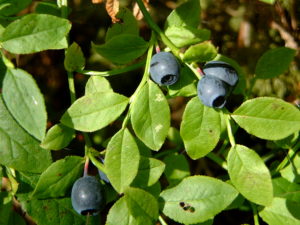PREVENTING LOSS OF HEALTH THROUGH NUTRITIONAL INTERVENTION
The “old” bilbe rry case
rry case
Eevia Health is in the business of preventing loss of health. We help people maintaining good health by providing nutritional ingredient products that have specific positive health effects. Brand holders around the world formulate our ingredients into their consumer brands.
Eevia has several new unique products with high concentration of phenolic compounds, which are found in natural raw materials such as wild berries, mushrooms and plants. These are abundant in the Northern part of the Nordic countries. The new products are innovative and exciting. Why then do we keep Bilberry (Vaccinium myrtillus) extracts with high concentration of anthocyanins (36% HPLC), which really is becoming “old news”, so close to our core?
One reason is that polyphenols in general is such a grateful starting point for our quest for new powerful solutions to health problems. There is substantial epidemiological evidence that polyphenol enriched diet protects against many serious health problems, such as developing cardiovascular disease, type 2 diabetes, eye-problems and inflammations.
Anthocyanins are an important sub-group of polyphenols. Anthocyanins, including those from bilberry, are well researched bioactives. A simple search on anthocyanins in the PubMed scientific database today November 2nd shows that 7594 scientific articles are listed for anthocyanins. We also found 164 scientific review- and meta-study articles.
Numerous studies, including in humans, have suggested that anthocyanins may play important roles in helping to reduce the risk of key health challenges, such as cardiovascular disease (CVD), cognitive decline and cancer. The role of anthocyanins in the prevention of these diseases has been linked to their antioxidant properties. Recent research suggests that anthocyanins’ health benefits may result from other chemical properties beyond their antioxidant capacity (see Hidalgo M, Martin-Santamaria S, Recio I, et al. Potential anti-inflammatory, anti-adhesive, anti/estrogenic, and angiotensin-converting enzyme inhibitory activities of anthocyanins and their gut metabolites. Genes Nutr. 2012;7(2):295-306)
Inflammation and problems from the metabolic syndrome is one significant health issue. We know that chronic low-grade inflammation plays a pivotal role in the pathogenesis of obesity, due to its associated chronic diseases such as type II diabetes and pulmonary diseases. Targeting inflammation is an attractive strategy to counter the burden of obesity-induced health problems. Recently, anthocyanins has been spotlighted as a regulator against various chronic diseases due to their low toxicity, as opposed to drugs that induce severe side effects
Bilberry has high amounts of anthocyanins and there is substantial epidemiological evidence that a diet high in polyphenol protects against developing the mentioned health problems. The absorption and metabolism of anthocyanins have been well described. However, the gut microbiota may also play a critical role in absorption. Insulin resistance is an abnormal physiological state that occurs when insulin from pancreatic β-cells is unable to trigger a signal transduction pathway in target organs such as the liver, muscles and adipose tissues. The loss of insulin sensitivity is generally associated with persistent hyperglycemia (diabetes), hyperinsulinemia, fatty acids and/or lipid dysregulation, which are often prevalent under obesity conditions. A number of natural products with multiple modes of actions has been identified to enhance insulin sensitivity in target organs. This includes dietary anthocyanins. Data from their in vitro, in vivo and clinical studies show their potential health benefit through ameliorating insulin resistance. Specific mechanism of action ranging from targeting specific signal transduction receptors/enzymes to the general antioxidant and anti-inflammatory mechanisms of insulin resistance are suggested.
Eevia also is looking at eye-health effects of Bilberry extracts and we see other possible fields where the documentation of the positive effects may be expanded. For Eevia, bilberry is also interesting because it is a highly under-utilized natural resource. Estimates indicate that the annual biomass in Finland alone is in several hundred thousand tons, of which a mere ten thousand tons is actually harvested. The rest rot in the forest unutilized, with only a fraction eaten by animals.
We also have a strategy where every part of the berry can be utilized. By utilizing the whole berry, we increase the value of this resource making it more sustainable, and with our short production and value chain near the harvest areas, we minimize the carbon footprint and environmental impact from the manufacturing of the extracts.
As an example of new utilization, Eevia plans to launch new anti-microbial extracts from bilberry in 2018 with proven efficacy towards many dangerous germs, such as Staphylococcus aureus, Pseudomonas aeruginosa, Escherichia coli and Enterococcus faecalis to mention a few. These new antimicrobial fractions will be patented and are natural alternatives to synthetic antibiotica.
Eevia has already launched more basic berry products, such as various non-soluble berry powders, which may also be sold with standardized level of anthocyanins which other providers don’t have. Eevia had earlier 5 different grades of non-soluble berry powders, but, we have now decided to simplify our offering to one berry powder and one fiber powder, although both come also in freeze-dried version, which has high demand in Asia. The berry powder has similar nutritional profile as the whole berry, but water has been removed. For instance one will find protein (5 g/100 g), potassium, sodium, vitamin A, C and E (15 mg/100 g) and 4,1 g/100 g of polyunsaturated fatty acids together with the berry sugars (glucose, fructose, etc) and 42 g/100g of carbohydrates in the product, with 1 250kJ/100g of energy in the powder. In the fiber powder, all the berry sugar s and pigments have been removed.
However, still the core is the high concentration soluble extracts with high concentration of anthocyanins. The Eevia gold standard bilberry product is the Feno-Myrtillus 25, which has a concentration of 36 % anthocyanins (HPLC method), but we also offer extracts with 5% and 1.2% standardized anthocyanin concentrations.
Currently we are ramping up volumes and increasing capacity to meet high customer demand, and we will keep bilberry to our base because it is a solid, well documented polyphenol, which we can make at the highest quality to serve customers world wide.